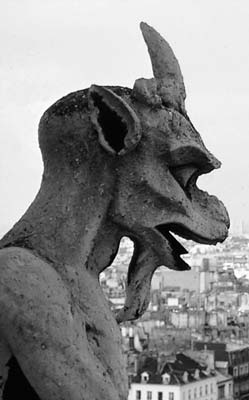
Historic Core of Paris: Notre-Dame, Sainte-Chapelle, and More
▲▲▲Notre-Dame Cathedral (Cathédrale Notre-Dame de Paris)
▲Deportation Memorial (Mémorial de la Déportation)
Cité Métropolitain Stop and Flower Market
Map: Major Museums Neighborhood
▲▲▲Orsay Museum (Musée d’Orsay)
▲▲Orangerie Museum (Musée de l’Orangerie)
▲▲▲Eiffel Tower (La Tour Eiffel)
▲Quai Branly Museum (Musée du Quai Branly)
National Maritime Museum (Musée National de la Marine)
Architecture and Monuments Museum (Cité de l’Architecture et du Patrimoine)
▲Paris Sewer Tour (Les Egouts de Paris)
▲▲Army Museum and Napoleon’s Tomb (Musée de l’Armée)
▲▲Marmottan Museum (Musée Marmottan Monet)
▲Latin Quarter (Quartier Latin)
▲▲Cluny Museum (Musée National du Moyen Age)
Delacroix Museum (Musée National Eugène Delacroix)
▲Luxembourg Garden (Jardin du Luxembourg)
▲Petit Palais (and the Musée des Beaux-Arts)
▲La Défense and La Grande Arche
▲▲Jacquemart-André Museum (Musée Jacquemart-André)
Marais Neighborhood and Nearby
▲Carnavalet Museum (Musée Carnavalet)
▲▲Picasso Musuem (Musée Picasso)
▲Jewish Art and History Museum (Musée d’Art et Histoire du Judaïsme)
Holocaust Memorial (Mémorial de la Shoah)
Map: Marais Neighborhood & Nearby
▲▲Pompidou Center (Centre Pompidou)
Promenade Plantée Park (Viaduc des Arts)
▲Père Lachaise Cemetery (Cimitière du Père Lachaise)
Montmartre Museum (Musée de Montmartre)
Paris is blessed with world-class museums and monuments—more than anyone could see in a single visit. To help you prioritize your limited time and money, I’ve chosen—with much difficulty—what I think are the best of Paris’ many sights. I’ve clustered them into walkable neighborhoods for more efficient sightseeing.
Note that some of Paris’ biggest sights—the Louvre, the Eiffel Tower, and others—are described in much more detail in the individual self-guided tour chapters. There you’ll also find crucial info on how to avoid lines, save money, and get a decent bite to eat nearby. If there’s more information on a sight elsewhere, it’s marked in this chapter with a  .
.
For tips on sightseeing, see here. For advice on saving money, see “Affording Paris’ Sights” on here. Also, be sure to check www.ricksteves.com/update for any significant changes that may have occurred since this book was printed.
If you plan ahead, you can avoid many of the lines that tourists suffer through in Paris. For most sightseers, the best choice is to buy a Paris Museum Pass. If you decide to forego the pass—or for sights not covered by the pass—you have other options.
In Paris there are two classes of sightseers—those with a Paris Museum Pass, and those who stand in line. The pass admits you to many of Paris’ most popular sights, allowing you to skip ticket-buying lines. You’ll save time and money by getting this pass.
The pass pays for itself with four key admissions in two days (for example, the Louvre, Orsay, Sainte-Chapelle, and Versailles), and it lets you skip the ticket line at most sights (2 days-€42, 4 days-€56, 6 days-€69, no youth or senior discounts). It’s sold at participating museums, monuments, FNAC department stores, and TIs (even at Paris’ airports). Try to avoid buying the pass at a major museum (such as the Louvre), where the supply can be spotty and lines long. It’s also not worth the cost or hassle to buy Paris Museum Passes online because you have to either pay dearly to have them shipped to you or print vouchers and redeem them in person at a Paris TI. For more info, visit www.parismuseumpass.com or call 01 44 61 96 60.
To determine if the pass is a good value for your trip, tally up what you want to see from the list in the next section. And remember, an advantage of the pass is that you skip to the front of most (but not all) lines, which can save hours of waiting, especially in summer. Another key benefit is that you can pop into lesser sights that otherwise might not be worth the expense.
Families: The pass isn’t worth buying for children and teens, as most museums are free or discounted for those under age 18 (teenagers may need to show ID as proof of age). If parents have a Museum Pass, kids can usually skip the ticket lines as well. A few places, such as the Arc de Triomphe and Army Museum, require everyone—even passholders—to stand in line to collect your child’s free ticket.
Most of the sights listed in this chapter are covered by the pass.
Here’s a list of key included sights and their admission prices without the pass:
| Louvre (€12) | Notre-Dame Tower (€8.50) |
| Orsay Museum (€11) | Paris Archaeological Crypt (€4) |
| Orangerie Museum (€8) | Paris Sewer Tour (€4.40) |
| Sainte-Chapelle (€8.50) | Cluny Museum (€8) |
| Arc de Triomphe (€9.50) | Pompidou Center (€13) |
| Rodin Museum (€6-9) | Picasso Museum (€10) |
| Army Museum (€9.50) | Conciergerie (€8.50) |
| Panthéon (€7.50) | Château of Chantilly (€14) |
| Château of Fontainebleau (€11) | |
| Versailles (€25 total—€15 for Château, €10 for Trianon Palaces and Domaine de Marie-Antoinette) | |
Notable exceptions that are not covered by the pass include: the Eiffel Tower, Montparnasse Tower, Marmottan Museum, Opéra Garnier, Notre-Dame Treasury, Jacquemart-André Museum, Grand Palais, Catacombs, Montmartre Museum, Sacré-Cœur’s dome, and the ladies of Pigalle. The pass also does not cover these recommended sights outside Paris: Vaux-le-Vicomte, Château d’Auvers in Auvers-sur-Oise, and Monet’s Garden and House in Giverny.
The pass is activated the first time you use it—you must write the starting date on the pass.
To use your pass at sights, look for signs designating the entrance for pre-reserved ticket holders. If it’s not obvious, boldly walk to the front of the ticket line (after going through security if necessary), hold up your pass, and ask the ticket taker: “Entrez, pass?” (ahn-tray pahs). You’ll either be allowed to enter at that point, or you’ll be directed to a special entrance. For major sights, such as the Louvre and Orsay museums, I’ve identified passholder entrances on the maps in this book. Don’t be shy—some places (Orsay Museum and the Arc de Triomphe, in particular) have long lines in which passholders wait needlessly. At a few sights (including the Louvre, Sainte-Chapelle, Notre-Dame Tower, and Château de Versailles), everyone has to shuffle through the slow-moving baggage-check lines for security—but you still save time by avoiding the ticket line.
Plan carefully to make the most of your pass. First, validate it only when you’re ready to tackle the covered sights on consecutive days. Make sure the sights you want to visit will be open (many museums are closed Mon or Tue). The pass provides the best value on days when sights close later, letting you extend your sightseeing day. Take advantage of these late hours. For instance, the Arc de Triomphe and Pompidou Center are always open later, while the Notre-Dame Tower, Sainte-Chapelle, Louvre, Orsay, Rodin, and Napoleon’s Tomb have late hours on selected evenings (or at certain times of year). On days that you don’t have pass coverage, plan to visit free sights and those not covered by the pass (see here for a list of free sights).
If you don’t purchase a Paris Museum Pass, or if a sight is not covered by the pass, you have other line-skipping options. For some sights, you can book tickets in advance at their official website. This is essential at the Eiffel Tower, which isn’t covered by the pass and is plagued by long lines in peak season (you must choose an entry time when booking). You can also buy tickets online for the Orsay, Rodin Museum, Monet’s gardens at Giverny, and the Jacquemart-André Museum, as well as for activities like the Bateaux-Mouches cruises and Sainte-Chapelle concerts. Increasingly, other sights are adding this helpful service.
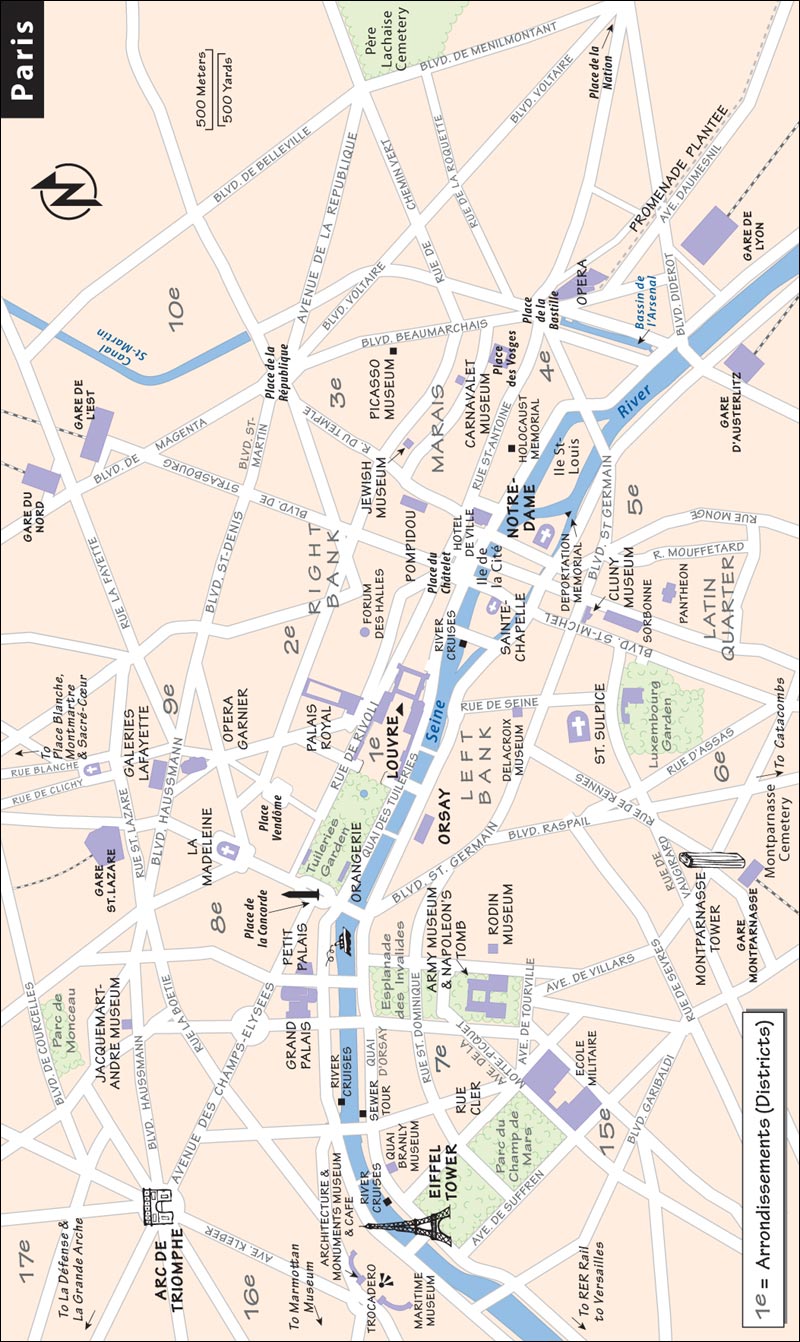
TIs and FNAC department stores sell individual “coupe-file” tickets for some sights, which allow you to use the Museum Pass entrance (worth the trouble only for the most important sights where lines are longest). TIs sell these tickets for no extra fee, but FNACs add a surcharge of 10-20 percent. FNAC stores are everywhere, even on the Champs-Elysées (ask your hotelier for the nearest one). Despite the surcharges and often-long lines to buy them, getting coupe-file (koop feel) tickets can still be a good idea.
Fat Tire Bike Tours offers Easy Pass skip-the-line tickets or tours of major sights, including the Louvre, Notre-Dame Tower, Catacombs, Eiffel Tower, Orsay, and Versailles (for more details see here or visit http://paris.easypasstours.com).
Some sights, such as the Louvre, have ticket-vending machines that save time in line. Note that these only accept cash (usually no bills larger than €20) or chip-and-PIN cards (so most American credit cards won’t work). At certain sights, including the Louvre and Orsay, nearby shops sell tickets, allowing you to avoid the main ticket lines (for details, see the Louvre and Orsay Museum tours).
Many of these sights are covered in detail in the  Historic Paris Walk chapter (also available as a free Rick Steves audio tour—see here). If a sight is covered in the walk, I’ve listed only its essentials here.
Historic Paris Walk chapter (also available as a free Rick Steves audio tour—see here). If a sight is covered in the walk, I’ve listed only its essentials here.
This 850-year-old cathedral is packed with history and tourists. With a pair of 200-foot-tall bell towers, a facade studded with ornate statuary, beautiful stained-glass rose windows, famous gargoyles, a picture-perfect Seine-side location, and textbook flying buttresses, there’s a good reason that this cathedral of “Our Lady” (Notre-Dame) is France’s most famous church.
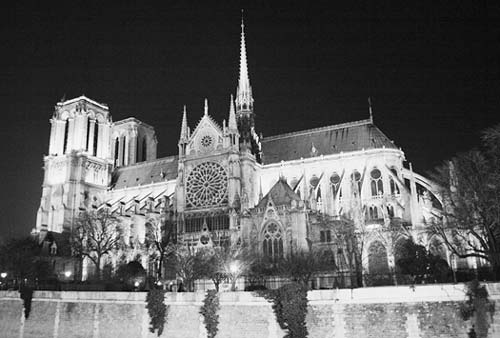
Check out the facade: Mary with the baby Jesus (in rose window) above the 28 Kings of Judah (statues that were beheaded during the Revolution). Stroll the interior, which echoes with history. Then wander around the exterior, through a forest of frilly buttresses, watched over by a fleet of whimsical gargoyles. The long line to the left is to climb the famous tower.
Cost and Hours: Cathedral—free, daily 7:45-18:45, Sun until 19:30; Tower—€8.50, covered by Museum Pass but no bypass line for passholders, daily April-Sept 10:00-18:30, Fri-Sat until 23:00 in July-Aug, Oct-March 10:00-17:30, last entry 45 minutes before closing, avoid the worst lines by arriving before 10:00 or after 17:00 (after 16:00 in winter); Treasury—€4, not covered by Museum Pass, Mon-Fri 9:30-18:00, Sat 9:30-18:30, Sun 13:30-18:40; audioguide-€5, free English tours—normally Wed-Thu at 14:00, Sat-Sun at 14:30; Mo: Cité, Hôtel de Ville, or St. Michel; tel. 01 42 34 56 10, www.notredamedeparis.fr.
For more on Notre-Dame (including scheduled Masses and viewings of the Crown of Thorns),  see here in the Historic Paris Walk chapter.
see here in the Historic Paris Walk chapter.
This intriguing 20-minute stop lets you view Roman ruins from Emperor Augustus’ reign (when this island became ground zero in Paris), trace the street plan of the medieval village, and see diagrams of how early Paris grew. It’s all thoughtfully explained in English (pick up the floor plan with some background info) and well-presented with videos and touchscreens.
The first few displays put the ruins in historical context. Three models show the growth of Paris—from an uninhabited riverside plot to the Roman town of Lutèce, then to an early-medieval city with a church that preceded Notre-Dame. A fourth model (off to the left) shows the current Notre-Dame surrounded by buildings, along with the old, straight road—Rue Neuve de Notre-Dame—that led up to the church and now runs right down the center of the museum. The ruins in the middle of the museum are a confusing mix of foundations from all these time periods, including parts of the old Rue Neuve de Notre-Dame.
You can also view models of Arènes de Lutèce, the Roman arena located on the Left Bank; step onto the remains of a Roman dock; see a Roman building with “hypocaustal” heating (narrow passages pumped full of hot air to heat the room); and get a chance to build Notre-Dame Cathedral with a touchscreen.
Cost and Hours: €4, covered by Museum Pass, Tue-Sun 10:00-18:00, closed Mon, last entry 30 minutes before closing, enter 100 yards in front of cathedral, tel. 01 55 42 50 10.
Climb down the steps into this memorial dedicated to the 200,000 French victims of the Nazi concentration camps. As Paris disappears above you, this monument draws you into the victims’ experience. Once underground you enter a one-way hallway studded with tiny lights commemorating the dead, leading you to an eternal flame.
Cost and Hours: Free, April-Sept Tue-Sun 10:00-12:30 & 13:30-18:45, Oct-March Tue-Sun 10:00-12:00 & 13:30-17:00 (lunch closure times can vary), closed Mon year-round, may randomly close at other times; at the east tip of the island named Ile de la Cité, behind Notre-Dame and near Ile St. Louis (Mo: Cité); mobile 06 14 67 54 98.
The residential island behind Notre-Dame is known for its restaurants (see the Eating in Paris chapter), great ice cream, and shops (along Rue St. Louis-en-l’Ile).
 Also see here in the Historic Paris Walk chapter.
Also see here in the Historic Paris Walk chapter.
In Place Louis Lépine, between the Notre-Dame and Sainte-Chapelle cathedrals, is an early-19th-century subway entrance and a flower market (which chirps with a bird market on Sun).
The interior of this 13th-century chapel is a triumph of Gothic church architecture. Built to house Jesus’ Crown of Thorns, Sainte-Chapelle is jam-packed with stained-glass windows, bathed in colorful light, and slippery with the drool of awestruck tourists. Ignore the humdrum exterior and climb the stairs into the sanctuary, where more than 1,100 Bible scenes—from the Creation to the Passion to Judgment Day—are illustrated by light and glass. There are tentative plans for Sainte-Chapelle to have a shared entrance with the Conciergerie at some point in the future.
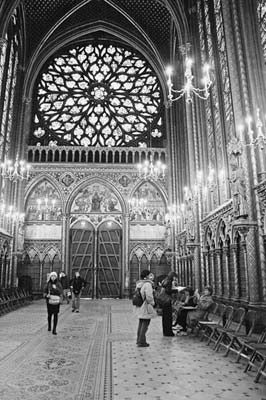
Cost and Hours: €8.50, €12.50 combo-ticket with Conciergerie, free for those under age 18, covered by Museum Pass; daily March-Oct 9:30-18:00, Wed until 21:30 mid-May-mid-Sept, Nov-Feb 9:00-17:00; last entry 30 minutes before closing, be prepared for long lines (for tips on avoiding them, see here), audioguide-€4.50 (€6 for two), evening concerts—see here, 4 Boulevard du Palais, Mo: Cité, tel. 01 53 40 60 80, http://sainte-chapelle.monuments-nationaux.fr.
For a detailed tour of the cathedral’s interior,  see here in the Historic Paris Walk chapter.
see here in the Historic Paris Walk chapter.
Marie-Antoinette was imprisoned here, as were Louis XVI, Robespierre, Danton, and many others on their way to the guillotine. Exhibits with good English descriptions trace the history of the building and give some insight into prison life. You can also relive the drama in Marie-Antoinette’s cell on the day of her execution—complete with dummies and period furniture.
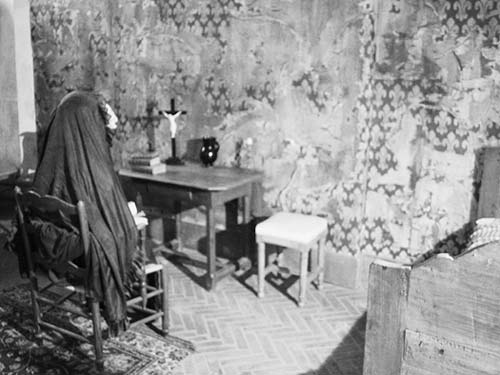
Cost and Hours: €8.50, €12.50 combo-ticket with Sainte-Chapelle, covered by Museum Pass, daily 9:30-18:00, last entry 30 minutes before closing, 2 Boulevard du Palais, Mo: Cité, tel. 01 53 40 60 80, http://conciergerie.monuments-nationaux.fr.
 Also see here in the Historic Paris Walk chapter.
Also see here in the Historic Paris Walk chapter.
The Riviera it’s not, but this string of fanciful faux beaches—assembled in summer along a one-mile stretch of the Right Bank of the Seine—is a fun place to stroll, play, and people-watch on a sunny day. Each summer, the Paris city government closes the embankment’s highway and trucks in potted palm trees, hammocks, lounge chairs, and 2,000 tons of sand to create colorful urban beaches. You’ll also find “beach cafés,” climbing walls, prefab pools, trampolines, boules, a library, beach volleyball, badminton, and Frisbee areas in three zones: sandy, grassy, and wood-tiled. (Other less-central areas of town, such as Bassin de la Vilette, have their own plages.)
Cost and Hours: Free, mid-July-mid-Aug daily 8:00-24:00, no beach off-season; on Right Bank of Seine, just north of Ile de la Cité, between Pont des Arts and Pont de Sully; for information, go to www.paris.fr, click on “English,” then “Visit,” then “Highlights.”
Paris’ grandest park, the Tuileries Garden, was once the private property of kings and queens. Today it links the Louvre, Orangerie, and Orsay museums. And across from the Louvre are the tranquil, historic courtyards of the Palais Royal.
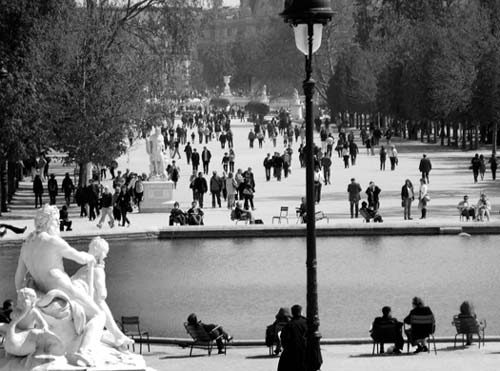
This is Europe’s oldest, biggest, greatest, and second-most-crowded museum (after the Vatican). Housed in a U-shaped, 16th-century palace (accentuated by a 20th-century glass pyramid), the Louvre is Paris’ top museum and one of its key landmarks. It’s home to Mona Lisa, Venus de Milo, and hall after hall of Greek and Roman masterpieces, medieval jewels, Michelangelo statues, and paintings by the greatest artists from the Renaissance to the Romantics (mid-1800s).
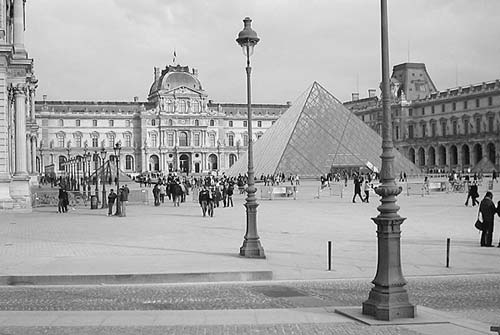
Touring the Louvre can be overwhelming, so be selective. Focus on the Denon wing (south, along the river), with Greek sculptures, Italian paintings (by Raphael and da Vinci), and—of course—French paintings (Neoclassical and Romantic), and the adjoining Sully wing, with Egyptian artifacts and more French paintings. For extra credit, tackle the Richelieu wing (north, away from the river), displaying works from ancient Mesopotamia (today’s Iraq), as well as French, Dutch, and Northern art.
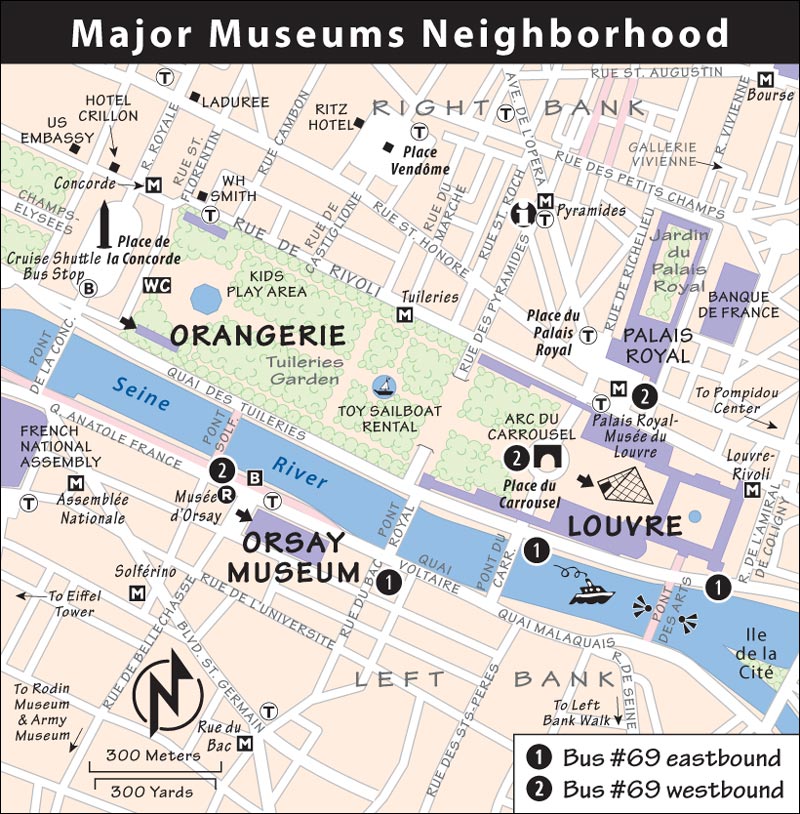
Cost and Hours: €12, free on first Sun of month Oct-March, covered by Museum Pass, tickets good all day, reentry allowed; Wed-Mon 9:00-18:00, Wed and Fri until 21:45 (except on holidays), closed Tue, galleries start shutting 30 minutes before closing, last entry 45 minutes before closing; crowds worst in the morning (arrive 30 minutes before opening) and all day Sun, Mon, and Wed; videoguide-€5, guided tours available—see here, free Rick Steves audio tour—see here, several cafés, tel. 01 40 20 53 17, recorded info tel. 01 40 20 51 51, www.louvre.fr.
Getting There: It’s at the Palais Royal-Musée du Louvre Métro stop. (The old Louvre Métro stop, called Louvre-Rivoli, is farther from the entrance.) Bus #69 also runs past the Louvre.
 See the Louvre Tour chapter.
See the Louvre Tour chapter.
Across from the Louvre are the lovely courtyards of the stately Palais Royal. Although the palace is closed to the public, the courtyards are open.
Cost and Hours: Free and always open. The Palais Royal is directly north of the Louvre on Rue de Rivoli (Mo: Palais Royal-Musée du Louvre).
Visiting the Courtyards: Enter through a whimsical (locals say tacky) courtyard filled with stubby, striped columns and playful fountains (with fun, reflective metal balls). Next, you’ll pass into another, perfectly Parisian garden. This is where in-the-know Parisians come to take a quiet break, walk their poodles and kids, or enjoy a rendezvous—amid flowers and surrounded by a serene arcade and a handful of historic restaurants. Bring a picnic and create your own quiet break, or have a drink at one of the outdoor cafés at the courtyard’s northern end. This is Paris.
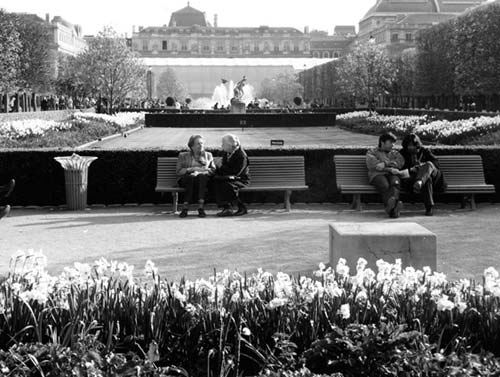
Though tranquil today, this was once a hotbed of political activism. The palace was built in the 17th century by Louis XIII and eventually became the headquarters of the powerful Dukes of Orléans. Because the Dukes’ digs were off-limits to the police, some shocking free thinking took root here. This was the meeting place for the debating clubs—the precursors to modern political parties. During the Revolution, palace resident Duke Phillip (nicknamed Phillip Egalité for his progressive ideas) advocated a constitutional monarchy, and he voted in favor of beheading Louis XVI—his own cousin. Phillip hoped his liberal attitudes would spare him from the Revolutionaries, but he, too, was guillotined. His son, Louis-Philippe, became France’s first constitutional monarch (r. 1830-1848). The palace’s courtyards were backdrops for a riotous social and political scene, filled with lively café culture, revolutionaries, rabble-rousers, scoundrels, and...Madame Tussaud’s first wax shop (she used the severed heads of guillotine victims to model her sculptures).
Nearby: Exiting the courtyard at the side facing away from the Seine brings you to the Galeries Colbert and Vivienne, attractive examples of shopping arcades from the early 1800s (see here).
The Orsay boasts Europe’s greatest collection of Impressionist works. It might be less important than the Louvre—but it’s more purely enjoyable.
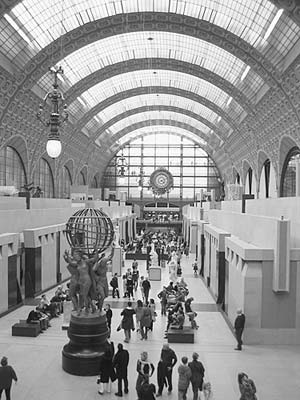
The Orsay, housed in an atmospheric old train station, picks up where the Louvre leaves off: the second half of the 19th century. This is art from the tumultuous time that began when revolutions swept across Europe in 1848 and ended when World War I broke out in 1914. Begin with the conservative art of the mid-1800s—careful, idealized Neoclassicism (with a few rebels mixed in). Then tour the late 1800s, when the likes of Manet, Monet, Degas, and Renoir jolted the art world with their colorful, lively new invention, Impressionism. (Somewhere in there, Whistler’s Mother sits quietly.) The Orsay also displays the works of their artistic descendants, the post-Impressionists: Cézanne, Van Gogh, Gauguin, Seurat, and Toulouse-Lautrec. On the mezzanine level, waltz through Rodin sculptures and Art Nouveau exhibits, and finish in the Grand Ballroom, which shows the chandeliered elegance of this former train station.
Cost and Hours: €11, €8.50 Tue-Wed and Fri-Sun after 16:30 and Thu after 18:15, free on first Sun of month and often right when the ticket booth stops selling tickets (Tue-Wed and Fri-Sun at 17:00, Thu at 21:00; they won’t let you in much after that), covered by Museum Pass, tickets valid all day, combo-ticket with Orangerie Museum (€16) or Rodin Museum (€15), valid four days, one visit per sight; open Tue-Sun 9:30-18:00, Thu until 21:45, closed Mon, Impressionist galleries start shutting 45 minutes before closing, last entry one hour before closing (45 minutes before on Thu); lines can be long (for line-avoiding tips, see here), museum especially crowded on Tue, when Louvre is closed; audioguide-€5, guided tours available—see here, free Rick Steves audio tour—see here; cafés and a restaurant, tel. 01 40 49 48 14, www.musee-orsay.fr.
Getting There: The museum, at 1 Rue de la Légion d’Honneur, sits above the RER-C stop called Musée d’Orsay; the nearest Métro stop is Solférino, three blocks southeast of the Orsay. Bus #69 also stops at the Orsay. From the Louvre, it’s a lovely 15-minute walk through the Tuileries Garden and across the pedestrian bridge to the Orsay.
 See the Orsay Museum Tour chapter.
See the Orsay Museum Tour chapter.
Located in the Tuileries Garden and drenched by natural light from skylights, the Orangerie (oh-rahn-zhuh-ree) is the closest you’ll ever come to stepping right into an Impressionist painting. Start with the museum’s claim to fame: Monet’s Water Lilies. Then head downstairs to enjoy the manageable collection of select works by Utrillo, Cézanne, Renoir, Matisse, and Picasso.
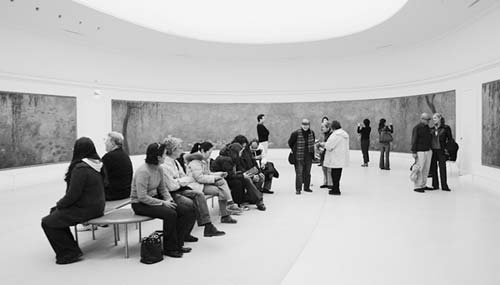
Cost and Hours: €8, €5 after 17:00, free for those under age 18, €16 combo-ticket with Orsay Museum (valid for four days, one visit per sight), covered by Museum Pass; Wed-Mon 9:00-18:00, closed Tue, galleries shut down 15 minutes before closing time; audioguide-€5, English guided tours usually Mon and Thu at 14:30 and Sat at 11:00, located in Tuileries Garden near Place de la Concorde (Mo: Concorde or scenic bus #24), 15-minute stroll from the Orsay, tel. 01 44 77 80 07, www.musee-orangerie.fr.
 See the Orangerie Museum Tour chapter.
See the Orangerie Museum Tour chapter.
Built on the 100th anniversary of the French Revolution (and in the spirit of the Industrial Revolution), the tower was the centerpiece of a World Expo designed simply to show off what people could build in 1889. For decades it was the tallest structure the world had ever known, and though it’s since been eclipsed, it’s still the most visited monument. Ride the elevators to the top of its 1,063 feet for expansive views that stretch 40 miles. Then descend to the two lower levels, where the views are arguably even better, since the monuments are more recognizable.
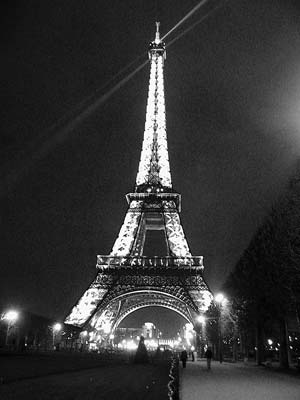
Cost and Hours: €15 all the way to the top, €9 for just the two lower levels, €5 to skip the elevator line and climb the stairs to the first or second level (€4 if you’re under age 25), not covered by Museum Pass; daily mid-June-Aug 9:00-24:45, last ascent to top at 23:00 and to lower levels at 24:00 (elevator or stairs); Sept-mid-June 9:30-23:45, last ascent to top at 22:30 and to lower levels at 23:00 (elevator) or at 18:00 (stairs); cafés and great view restaurants, Mo: Bir-Hakeim or Trocadéro, RER: Champ de Mars-Tour Eiffel (all stops about a 10-minute walk away).
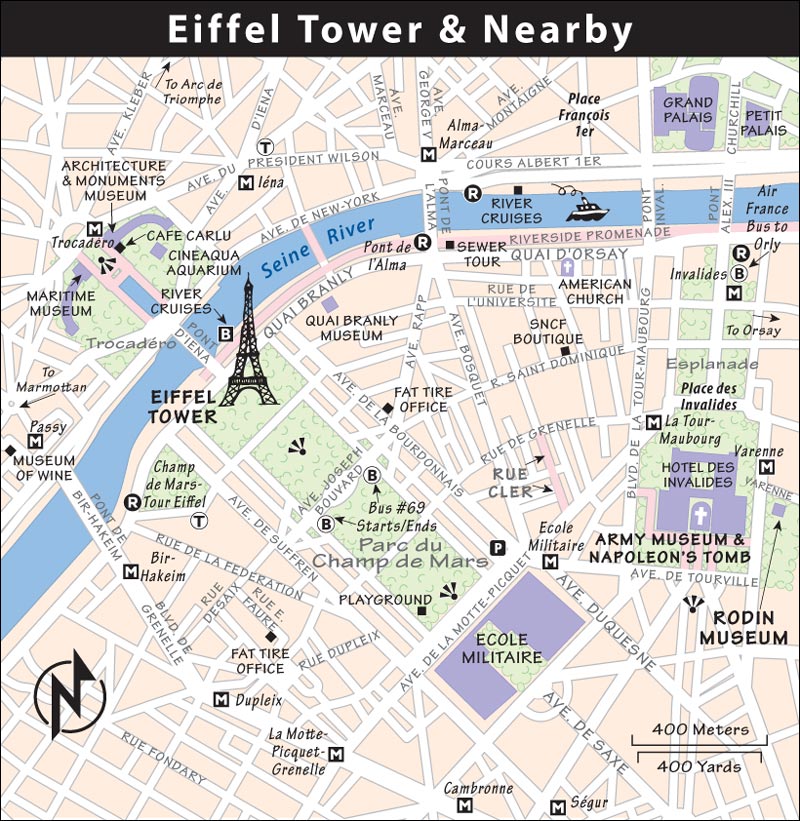
Reservations: Since one- to two-hour waits are common, it’s wise to make a reservation well in advance of your visit. An online reservation system allows you to book a time slot to begin your ascent (and skip the initial entry line)—check www.toureiffel.paris (tel. 01 44 11 23 23). Tickets go on sale about three months in advance and sell out quickly for visits from April through September, so don’t dally.
 See the Eiffel Tower Tour chapter (which includes more tips on making reservations online and avoiding lines).
See the Eiffel Tower Tour chapter (which includes more tips on making reservations online and avoiding lines).
This is the best collection I’ve seen anywhere of so-called Primitive art from Africa, Polynesia, Asia, and America. Because “art illustrates the way in which man organizes and delineates the boundaries of their lands,” we gain a better appreciation of a people through their art. The museum is presented in a wild, organic, and strikingly modern building. It’s well worth a look if you have a Museum Pass and are near the Eiffel Tower.
After passing the ticket taker, pick up the museum map, then follow a ramp upstream along a projected river of the 1,677 names of the peoples covered in the museum. Masks, statuettes, musical instruments, textiles, clothes, voodoo dolls, and a variety of temporary exhibitions and activities are artfully presented and exquisitely lit. There’s no need to follow a route: Wander at whim left and right, and read as much as feels right. Helpful English explanations are posted in most rooms and provide sufficient description for most visitors, though Primitive art lovers will want to rent the audioguide.
Cost and Hours: €9, free on first Sun of the month, covered by Museum Pass; museum—Tue-Sun 11:00-19:00, Thu-Sat until 21:00, closed Mon, ticket office closes one hour before closing; gardens—Tue-Sun 9:15-19:30, Thu-Sat until 21:15, closed Mon; audioguide-€5, 37 Quai Branly, 10-minute walk east (upriver) of Eiffel Tower, along the river (RER: Champ de Mars-Tour Eiffel or Pont de l’Alma), tel. 01 56 61 70 00, www.quaibranly.fr.
Eiffel Tower Views: Even if you skip the museum, drop by its peaceful garden café for fine Eiffel Tower views (closes 30 minutes before museum) and enjoy the intriguing gardens. The pedestrian bridge that crosses the river and runs up to the museum has sensational views of the Eiffel Tower.
This fun museum anchors a dazzling collection of ship models, submarine models, torpedoes, cannonballs, beaucoup bowsprits, and naval you-name-it. It’s a kid-friendly place filled with Pirates of the Caribbean-like ship models, some the size of small cars. Start with the full-sized party barge made for Napoleon in 1810, then look up to see the elaborate stern of the 1694 Réale de France royal galley (don’t miss the scale model in the glass case). From here you can follow a more or less chronological display of ship construction, from Roman vessels to modern cruise ships to aircraft carriers. Few English explanations make the free audioguide essential.
Cost and Hours: €8.50, free for those age 26 and under, covered by Museum Pass; Mon and Wed-Fri 11:00-18:00, Sat-Sun 11:00-19:00, closed Tue; includes audioguide, on left side of Place du Trocadéro with your back to Eiffel Tower, tel. 01 53 65 69 69, www.musee-marine.fr.
This museum, on the east side of Place du Trocadéro, takes you through 1,000 years of French architecture, brilliantly displaying full-sized casts and models of some of France’s most cherished monuments from the 11th to 21st centuries. Pick up the museum plan, and spend most of your time on the ground floor. Gaze into the eyes of medieval statues and wander under doorways, tympanums, and arches from the abbey of Cluny, Chartres Cathedral, Château de Chambord, and much more. For a good background, you can borrow the English info sheets (available in most rooms), or you can rent an audioguide.
Take the elevator up a floor to discover a vast array of models from modern projects, including thought-provoking designs for low-income housing. You can walk into a full-scale model of Le Corbusier’s 1952 Habitation Unit from Marseille and appreciate what a forward thinker this man was. Later, you’ll see how colorfully painted the chapels were in medieval churches. The views from the upper rooms to the Eiffel Tower are sensational, as are those from the terrace of the museum’s café, Café Carlu.
Cost and Hours: €8, covered by Museum Pass, Wed-Mon 11:00-19:00, Thu until 21:00, closed Tue, includes audioguide or you can hunt for handheld English explanations, great views from outside tables at on-site Café Carlu (reasonable prices, open same hours as museum and does not require entry into the museum), 1 Place du Trocadéro, Mo: Trocadéro, RER: Champ de Mars-Tour Eiffel, tel. 01 58 51 52 00, www.citechaillot.fr.
Step out of urban Paris and into this 15th-century cellar for a musty, atmospheric, wine-fueled experience. The museum displays tools and items used for harvesting and winemaking, collected over the years by the Confrérie des Echansons. The role of this order is to protect and promote French wines. Started in 1954, it has thousands of members worldwide. Follow your visit with a wine tasting (€5 for one glass, €25 to taste three wines with a sommelier) and/or lunch at the restaurant (open 12:00-15:00, free apéritif with lunch if you show this book).
Cost and Hours: €10, €8 with this book, Tue-Sat 10:00-18:00, closed Sun-Mon, free but dry audioguide in English, 5 Square Charles Dickens, Mo: Passy, 15-minute walk from Eiffel Tower, tel. 01 45 25 63 26, www.museeduvinparis.com.
Discover what happens after you flush. This quick, interesting, and slightly stinky visit (a perfumed hanky helps) takes you along a few hundred yards of water tunnels in the world’s first underground sewer system. Pick up the helpful English self-guided tour, then drop down into Jean Valjean’s world of tunnels, rats, and manhole covers. (Victor Hugo was friends with the sewer inspector when he wrote Les Misérables.) You’ll pass well-organized displays with extensive English information explaining the history of water distribution and collection in Paris, from Roman times to the present. The evolution of this amazing network of sewers is surprisingly fascinating. More than 1,500 miles of tunnels carry 317 million gallons of water daily through this underworld. It’s the world’s longest sewer system—so long, they say, that if it were laid out straight, it would stretch from Paris all the way to Istanbul.
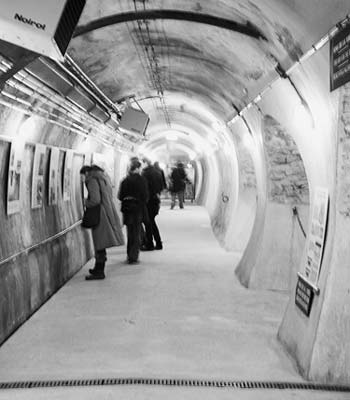
It’s enlightening to see how much work goes into something we take for granted. Sewage didn’t always disappear so readily. In the Middle Ages, wastewater was tossed from windows to a center street gutter, then washed into the river. In castles, sewage ended up in the moat (enhancing the moat’s defensive role). In the 1500s, French Renaissance King François I moved from château to château (he had several) when the moat-muck became too much.
Ask in the gift shop about the slideshow and occasional tours in English. WCs are just beyond the gift shop.
Cost and Hours: €4.40, covered by Museum Pass, May-Sept Sat-Wed 11:00-17:00, Oct-April Sat-Wed 11:00-16:00, closed Thu-Fri, located where Pont de l’Alma greets the Left Bank—on the right side of the bridge as you face the river, Mo: Alma-Marceau, RER: Pont de l’Alma, tel. 01 53 68 27 81.
Europe’s greatest military museum, in the Hôtel des Invalides, provides interesting coverage of several wars, particularly World Wars I and II. At the center of the complex, Napoleon lies majestically dead inside several coffins under a grand dome—a goose-bumping pilgrimage for historians. The dome overhead glitters with 26 pounds of thinly pounded gold leaf.
Cost and Hours: €9.50, €7.50 after 16:00, free for military personnel in uniform, free for kids but they must wait in line for ticket, covered by Museum Pass, temporary exhibits are extra; daily 10:00-18:00, July-Aug until 19:00, Nov-March until 17:00, tomb plus WWI and WWII wings open Tue until 21:00 April-Sept, museum (except for tomb) closed first Mon of month Oct-June, Charles de Gaulle exhibit closed Mon year-round, last tickets sold 30 minutes before closing; videoguide-€6, cafeteria, tel. 01 44 42 38 77 or 08 10 11 33 99, www.musee-armee.fr.
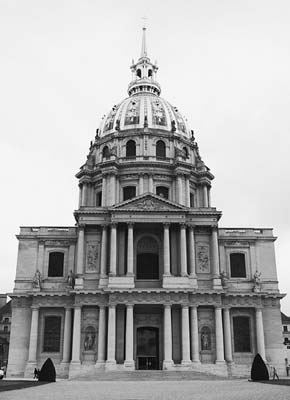
Getting There: The Hôtel des Invalides is at 129 Rue de Grenelle, a 10-minute walk from Rue Cler (Mo: La Tour Maubourg, Varenne, or Invalides). You can also take bus #69 (from the Marais and Rue Cler) or bus #87 (from Rue Cler and Luxembourg Garden area).
 See the Army Museum and Napoleon’s Tomb Tour chapter.
See the Army Museum and Napoleon’s Tomb Tour chapter.
This user-friendly museum is filled with passionate works by the greatest sculptor since Michelangelo. You’ll see The Kiss, The Thinker, The Gates of Hell, and many more. (Due to ongoing renovations extending into 2015, some rooms may be closed.)
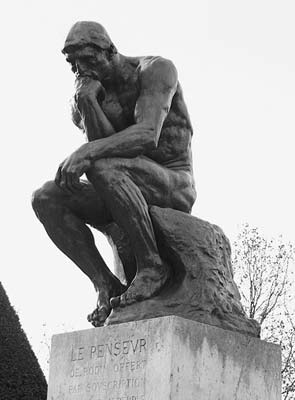
Well-displayed in the mansion where the sculptor lived and worked, exhibits trace Rodin’s artistic development, explain how his bronze statues were cast, and show some of the studies he created to work up to his masterpiece (the unfinished Gates of Hell). Learn about Rodin’s tumultuous relationship with his apprentice and lover, Camille Claudel. Mull over what makes his sculptures some of the most evocative since the Renaissance. And stroll the gardens, packed with many of his greatest works (including The Thinker). The beautiful gardens are ideal for artistic reflection.
Cost and Hours: €6-9 (depending on temporary exhibits), free for those under age 18, free on first Sun of the month, €2 for garden only (possibly Paris’ best deal, as several important works are on display there), €15 combo-ticket with Orsay Museum (valid four days, one visit per sight), both museum and garden covered by Museum Pass; Tue-Sun 10:00-17:45, Wed until 20:45, closed Mon; gardens close at 18:00, Oct-March at 17:00; last entry 30 minutes before closing; audioguide-€6, mandatory baggage check, self-service café in garden, 79 Rue de Varenne, Mo: Varenne, tel. 01 44 18 61 10, www.musee-rodin.fr.
 See the Rodin Museum Tour chapter.
See the Rodin Museum Tour chapter.
In this private, intimate, and untouristy museum, you’ll find the best collection anywhere of works by Impressionist headliner Claude Monet. Follow Monet’s life through more than a hundred works, from simple sketches to the Impression: Sunrise painting that gave his artistic movement its start—and a name. The museum also displays some of the enjoyable large-scale canvases featuring the water lilies from his garden at Giverny.
Cost and Hours: €10, not covered by Museum Pass, Tue-Sun 10:00-18:00, Thu until 20:00, closed Mon, last entry 30 minutes before closing, audioguide-€3, 2 Rue Louis-Boilly, Mo: La Muette, tel. 01 44 96 50 33, www.marmottan.fr.
 See the Marmottan Museum Tour chapter.
See the Marmottan Museum Tour chapter.
For more information on these sights,  see the Left Bank Walk, the Historic Paris Walk (which dips into the Latin Quarter), and the “Sèvres-Babylone to St. Sulpice” stroll in the Shopping in Paris chapter.
see the Left Bank Walk, the Historic Paris Walk (which dips into the Latin Quarter), and the “Sèvres-Babylone to St. Sulpice” stroll in the Shopping in Paris chapter.
This Left Bank neighborhood, just opposite Notre-Dame, was the center of Roman Paris. But the Latin Quarter’s touristy fame relates to its intriguing, artsy, bohemian character. This was perhaps Europe’s leading university district in the Middle Ages, when Latin was the language of higher education. The neighborhood’s main boulevards (St. Michel and St. Germain) are lined with cafés—once the haunts of great poets and philosophers, now the hangouts of tired tourists. Though still youthful and artsy, much of this area has become a tourist ghetto filled with cheap North African eateries. Exploring a few blocks up or downriver from here gives you a better chance of feeling the pulse of what survives of Paris’ classic Left Bank.
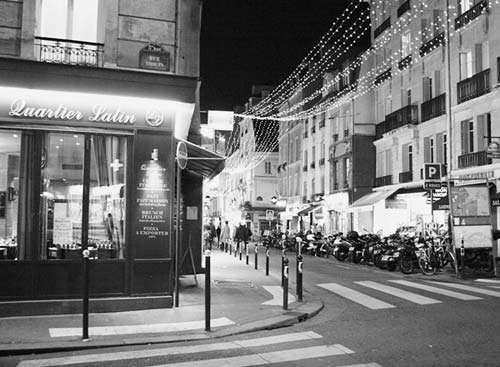
 See the Left Bank Walk chapter.
See the Left Bank Walk chapter.
This treasure trove of Middle Ages (Moyen Age) art fills old Roman baths, offering close-up looks at stained glass, Notre-Dame carvings, fine goldsmithing and jewelry, and rooms of tapestries. The star here is the exquisite Lady and the Unicorn series of six tapestries: A delicate, as-medieval-as-can-be noble lady introduces a delighted unicorn to the senses of taste, hearing, sight, smell, and touch.
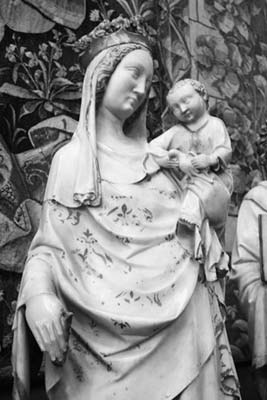
Cost and Hours: €8, free on first Sun of month, covered by Museum Pass; Wed-Mon 9:15-17:45, closed Tue, ticket office closes at 17:15; ticket includes audioguide though passholders must pay €1; near corner of Boulevards St. Michel and St. Germain at 6 Place Paul Painlevé; Mo: Cluny-La Sorbonne, St. Michel, or Odéon; tel. 01 53 73 78 16, www.musee-moyenage.fr.
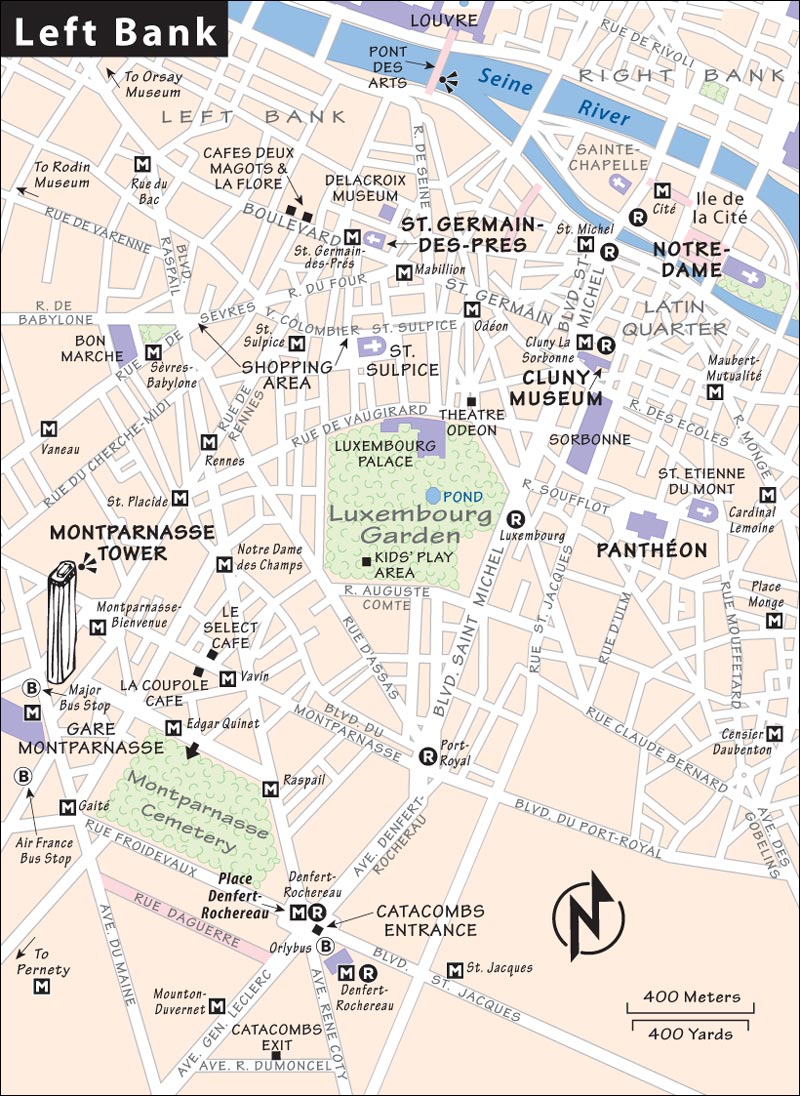
 See the Cluny Museum Tour chapter.
See the Cluny Museum Tour chapter.
A church was first built on this site in A.D. 558. The church you see today was constructed in 1163 and is all that’s left of a once sprawling and influential monastery. The colorful interior reminds us that medieval churches were originally painted in bright colors. The surrounding area hops at night with venerable cafés, fire-eaters, mimes, and scads of artists.
Cost and Hours: Free, daily 8:00-20:00, Mo: St. Germain-des-Prés.
After it was featured in The Da Vinci Code, this grand church became a popular stop for the book’s many fans. For pipe-organ enthusiasts, a visit here is one of Europe’s great musical treats. The Grand Orgue at St. Sulpice Church has a rich history, with a succession of 12 world-class organists—including Charles-Marie Widor and Marcel Dupré—that goes back 300 years.
Patterned after St. Paul’s Cathedral in London, the church has a Neoclassical arcaded facade and two round towers. Inside, in the first chapel on the right, are three murals of fighting angels by Delacroix: Jacob Wrestling the Angel, Heliodorus Chased from the Temple, and The Archangel Michael (on the ceiling). The fourth chapel on the right has a statue of Joan of Arc and wall plaques listing hundreds from St. Sulpice’s congregation who died during World War I. The north transept wall features an Egyptian-style obelisk used as a gnomon (part of a sundial). The last chapel before the exit has a display on the Shroud of Turin.
Cost and Hours: Free, church open daily 7:30-19:30, Mo: St. Sulpice or Mabillon. See www.stsulpice.com for special concerts.
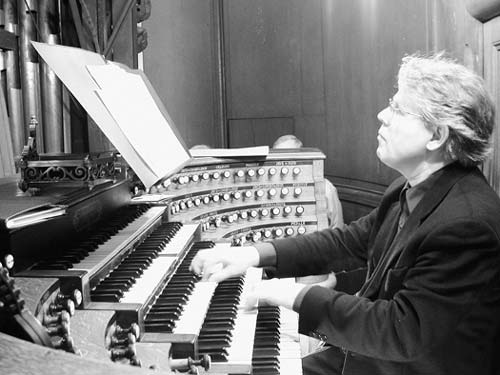
Sunday Organ Recitals: Though the (once-tourable) organ loft is no longer open to visitors, you can always hear the organ played at Sunday Mass (10:30-11:30, come appropriately dressed) followed by a high-powered 25-minute recital, usually performed by talented organist Daniel Roth.
Nearby: Tempting boutiques surround the church (see the Shopping in Paris chapter), and Luxembourg Garden is nearby.
For more on St. Sulpice,  see here in the Left Bank Walk chapter.
see here in the Left Bank Walk chapter.
This museum for Eugène Delacroix (1798-1863) was once his home and studio. A friend of bohemian artistic greats—including George Sand and Frédéric Chopin—Delacroix is most famous for the flag-waving painting Liberty Leading the People, which is displayed at the Louvre, not here.
Cost and Hours: €6, free on first Sun of the month, covered by Museum Pass, Wed-Mon 9:30-17:00, closed Tue, last entry 30 minutes before closing, 6 Rue de Furstenberg, Mo: St. Germain-des-Prés, tel. 01 44 41 86 50, www.musee-delacroix.fr.
For more on the Delacroix Museum,  see here in the Left Bank Walk chapter.
see here in the Left Bank Walk chapter.
This lovely 60-acre garden is an Impressionist painting brought to life. Slip into a green chair pondside, enjoy the radiant flower beds, go jogging, play tennis or basketball, sail a toy sailboat, or take in a chess game or puppet show. Some of the park’s prettiest (and quietest) sections lie around its perimeter. Notice any pigeons? The story goes that a very poor Ernest Hemingway used to hand-hunt (read: strangle) them here.
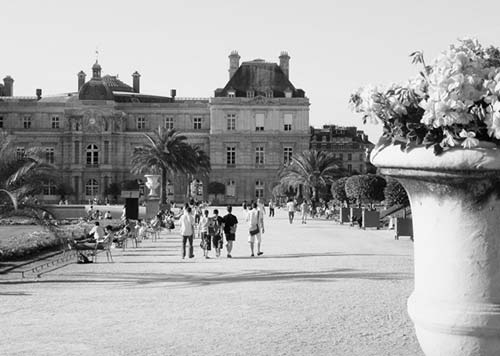
Cost and Hours: Free, daily dawn until dusk, Mo: Odéon, RER: Luxembourg.
 For more on the garden and nearby sights, see here in the Left Bank Walk chapter. Also see the kid-friendly activities in the garden (Paris with Children chapter), cafés listed in “Les Grands Cafés de Paris” (Eating in Paris chapter), and the description of the Panthéon mausoleum (below).
For more on the garden and nearby sights, see here in the Left Bank Walk chapter. Also see the kid-friendly activities in the garden (Paris with Children chapter), cafés listed in “Les Grands Cafés de Paris” (Eating in Paris chapter), and the description of the Panthéon mausoleum (below).
Other Parks: If you enjoy Luxembourg Garden and want to see more green spaces, you could visit the more elegant Parc Monceau (Mo: Monceau), the colorful Jardin des Plantes (Mo: Jussieu or Gare d’Austerlitz, RER: Gare d’Austerlitz), or the hilly and bigger Parc des Buttes-Chaumont (Mo: Buttes-Chaumont).
This state-capitol-style Neoclassical monument celebrates France’s illustrious history and people, balances Foucault’s pendulum, and is the final home of many French VIPs. In 1744, an ailing King Louis XV was miraculously healed by St. Geneviève, the city’s patron saint, and he thanked her by replacing her ruined church with a more fitting tribute. By the time the church was completed (1791), however, the secular-minded Revolution was in full swing, and the church was converted into a nonreligious mausoleum honoring the “Champions of French liberty”: Voltaire, Rousseau, Descartes, and others. The Revolutionaries covered up the church’s windows (as you can see from outside) to display grand, patriotic murals. On the entrance pediment (inspired by the ancient Pantheon in Rome), they carved the inscription, “To the great men of the Fatherland.”
Cost and Hours: €7.50, free for those under age 18, covered by Museum Pass, daily 10:00-18:30 in summer, until 18:00 in winter, last entry 45 minutes before closing, Mo: Cardinal Lemoine, tel. 01 44 32 18 00, pantheon.monuments-nationaux.fr.
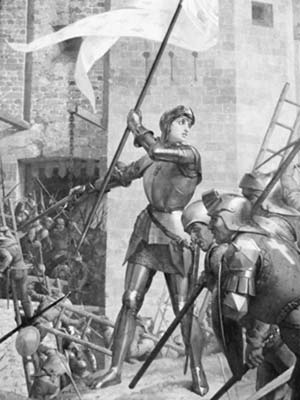
Visiting the Panthéon: Inside the vast building (360’ by 280’ by 270’) are monuments tracing the celebrated struggles of the French people: a beheaded St. Denis (painting on left wall of nave), St. Geneviève saving the fledgling city from Attila the Hun, and scenes of Joan of Arc (left transept).
Under the dome are four statue groups dedicated to more great Frenchmen: Jean-Jacques Rousseau (1712-1778), the philosopher who championed the idea of an equal Social Contract between government and the people; Diderot (1713-1784), whose Encyclopédie championed secular knowledge; orators and publicists (men in business suits) who served the state; and generals, including Napoleon on horseback.
Foucault’s pendulum swings gracefully at the end of a 220-foot cable suspended from the towering dome (under renovation through 2015). It was here in 1851 that the scientist Léon Foucault first demonstrated the rotation of the earth. If the pendulum is back by the time you visit, stand a few minutes and watch its arc (appear to) shift as you and the earth rotate beneath it.
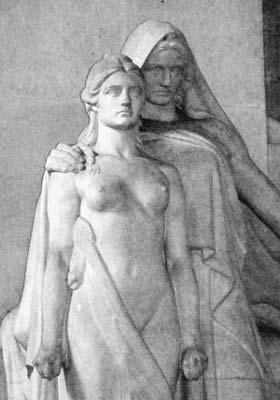
At the far end of the nave stands an inspirational altar dedicated to the political body that opposed the monarchy during the Revolution, inscribed with the familiar motto “Live free or die.”
Stairs in the back lead down to the crypt, where a pantheon of greats is buried. Rousseau is along the right wall as you enter, Voltaire faces him across the hall. Also buried here are scientist Marie Curie, Victor Hugo (Les Misérables, The Hunchback of Notre-Dame), Alexandre Dumas (The Three Musketeers, The Count of Monte Cristo), and Louis Braille, who invented the script for the blind.
This sadly out-of-place 59-story superscraper has one virtue: If you can’t make it up the Eiffel Tower, the views from this tower are cheaper, far easier to access, and make for a fair consolation prize. Come early in the day for clearest skies and shortest lines, and be treated to views from a comfortable interior and from up on the rooftop. (Some say it’s the very best view in Paris, as you can see the Eiffel Tower clearly...and you can’t see the Montparnasse Tower at all.)
Cost and Hours: €14.50, not covered by Museum Pass; April-Sept daily 9:30-23:30; Oct-March Sun-Thu 9:30-22:30; Fri-Sat 9:30-23:00; last entry 30 minutes before closing, dodge tour groups that clog the small elevators, sunset is great but views are disappointing after dark, entrance on Rue de l’Arrivée, Mo: Montparnasse-Bienvenüe—from the Métro, stay inside the station and follow La Tour signs; tel. 01 45 38 52 56, www.tourmontparnasse56.com.
Visiting the Tower: Find the view elevator entrance near the skyscraper’s main entry (under the awning marked Paris Tout A 360). Exit the elevator at the 56th floor, passing the eager photographer (they’ll superimpose your group’s image with the view). Here you can marvel at the views of tout Paris (good even if cloudy), have a drink or a light lunch (OK prices), and peruse the gift shop. Take time to explore every corner of the floor. Exhibits identify highlights of the star-studded vista.
Next, climb three flights of steps (behind the photographer) to the open terrace on the 59th floor to enjoy magnificent views in all directions (and a surprise helipad). Here, 690 feet above Paris, you can scan the city through glass panels that limit wind. The view over Luxembourg Garden is terrific, as is the view up the Champs de Mars to the Eiffel Tower. Montparnasse Cemetery is immediately below, and the high-rise suburbs lie immediately to the west. From this vantage, it’s easy to admire Baron Georges-Eugène Haussmann’s grand-boulevard scheme (see sidebar on here). Notice the lush courtyards hiding behind grand street fronts.
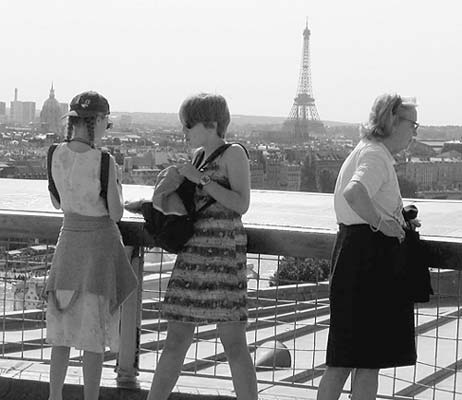
Sightseeing Tip: The tower is an efficient stop when combined with a day trip to Chartres, which begins at the Montparnasse train station (see the Chartres chapter for details).
Descend 60 feet below the street and walk a one-mile (one-hour) route through tunnels containing the anonymous bones of six million permanent Parisians.
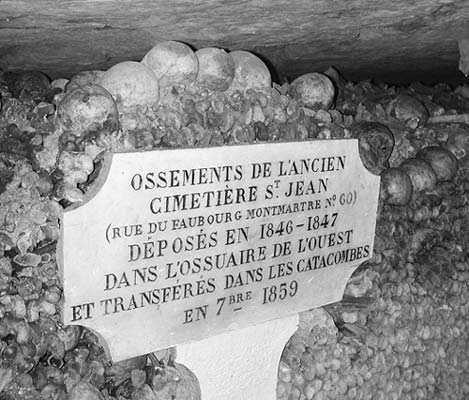
In 1786, health-conscious Parisians looking to relieve congestion and improve the city’s sanitary conditions emptied the church cemeteries and moved the bones here, to former limestone quarries. For decades, priests led ceremonial processions of black-veiled, bone-laden carts into the quarries, where the bones were stacked in piles five feet high and as much as 80 feet deep. Descend 130 steps and ponder the sign announcing, “Halt, this is the empire of the dead.” Shuffle through passageways of skull-studded tibiae, admire 300-year-old sculptures cut into the walls of the catacombs, and see more cheery signs: “Happy is he who is forever faced with the hour of his death and prepares himself for the end every day.” Then climb 86 steps to emerge far from where you entered, with white-limestone-covered toes, telling everyone you’ve been underground gawking at bones. Note to wannabe Hamlets: An attendant checks your bag at the exit for stolen souvenirs.
Cost and Hours: €8, not covered by Museum Pass, Tue-Sun 10:00-17:00, closed Mon; lines are long (figure 1.5 hours of waiting)—arrive by 9:30 to minimize the wait; ticket booth closes at 16:00, come no later than 14:30 or risk not getting in.
Tours and Information: English tours may be offered on Tue and Wed at 12:00 for €4.50. Call ahead or check online to confirm times, show up an hour ahead, go to the front of the line to ask for a ticket, and cross your fingers. If visiting on your own, pick up the free brochure (English version available) for some helpful background. Photos are allowed, but flashes and tripods are not, making most photography hopeless. Tel. 01 43 22 47 63, www.catacombes.paris.fr.
Getting There: 1 Place Denfert-Rochereau. Take the Métro to Denfert-Rochereau, then find the lion in the big traffic circle; if he looked left rather than right, he’d stare right at the green entrance to the Catacombs.
After Your Visit: You’ll exit at 36 Rue Rémy Dumoncel, far from where you started. Turn right out of the exit and walk to Avenue du Général Leclerc, where you’ll be equidistant from Métro stops Alésia (walk left) and Mouton Duvernet (walk right). Traffic-free Rue Daguerre, a pleasing pedestrian street (see the Shopping in Paris chapter), is four blocks to the right on Avenue du Général Leclerc (a block from where you entered the Catacombs).
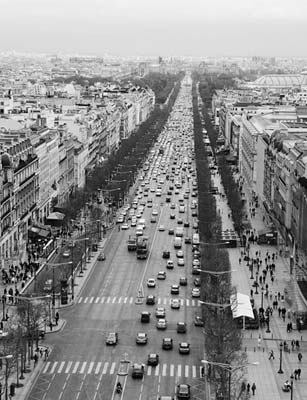
This famous boulevard is Paris’ backbone, with its greatest concentration of traffic. From the Arc de Triomphe down Avenue des Champs-Elysées, all of France seems to converge on Place de la Concorde, the city’s largest square. And though the Champs-Elysées has become as international as it is Parisian, a walk here is still a must.
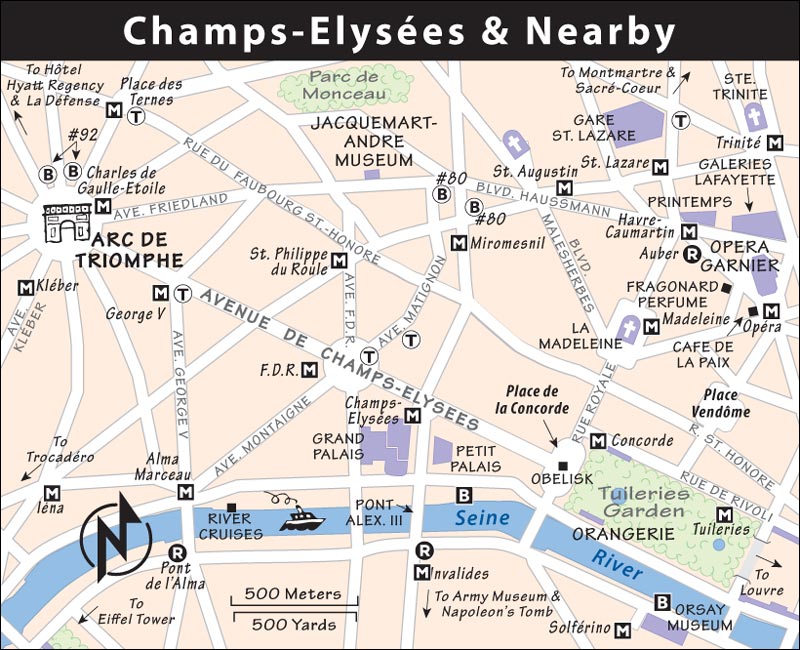
To reach the top of the Champs-Elysées, take the Métro to the Arc de Triomphe (Mo: Charles de Gaulle-Etoile), then saunter down the grand boulevard (Métro stops every few blocks, including George V and Franklin D. Roosevelt).
 See the Champs-Elysées Walk chapter.
See the Champs-Elysées Walk chapter.
Napoleon had the magnificent Arc de Triomphe commissioned to commemorate his victory at the battle of Austerlitz. The foot of the arch is a stage on which the last two centuries of Parisian history have played out—from the funeral of Napoleon to the goose-stepping arrival of the Nazis to the triumphant return of Charles de Gaulle after the Allied liberation. Examine the carvings on the pillars, featuring a mighty Napoleon and excitable Lady Liberty. Pay your respects at the Tomb of the Unknown Soldier. Then climb the 284 steps to the observation deck up top, with sweeping skyline panoramas and a mesmerizing view down onto the traffic that swirls around the arch.
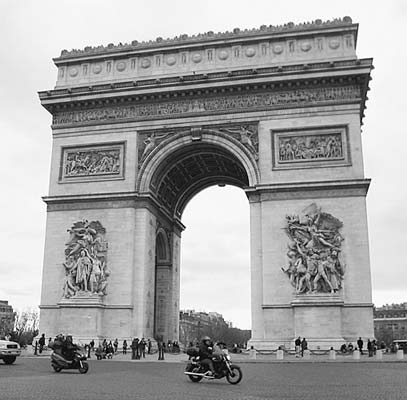
Cost and Hours: Outside and at the base—free, always viewable; steps to rooftop—€9.50, free for those under age 18, free on first Sun of month Oct-March, covered by Museum Pass; daily April-Sept 10:00-23:00, Oct-March 10:00-22:30, last entry 45 minutes before closing; lines are slow—see here for advice; Place Charles de Gaulle, use underpass to reach arch, Mo: Charles de Gaulle-Etoile, tel. 01 55 37 73 77, http://arc-de-triomphe.monuments-nationaux.fr.
 See the Champs-Elysées Walk chapter.
See the Champs-Elysées Walk chapter.
This free museum displays a broad collection of paintings and sculpture from the 1600s to the 1900s on its ground floor, and an easy-to-appreciate collection of art from Greek antiquities to Art Nouveau in its basement. Though it houses mostly second-tier art, there are a few diamonds in the rough (including pieces by Rembrandt, Courbet, and Monet). The building itself is impressive, and the museum’s classy café merits the detour. If it’s raining and your Museum Pass has expired, the Petit Palais is a worthwhile stop.
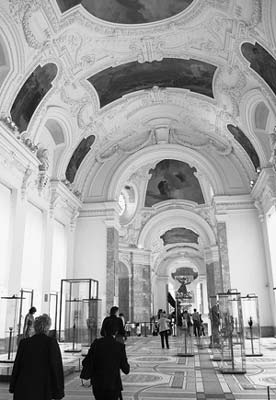
Cost and Hours: Free, Tue-Sun 10:00-18:00, Thu until 20:00 for temporary exhibitions (fee for those exhibits), closed Mon; audioguide-€5; across from Grand Palais on Avenue Winston Churchill, a looooong block west of Place de la Concorde, Mo: Champs-Elysées Clemenceau; tel. 01 53 43 40 00, www.petitpalais.paris.fr.
Visiting the Museum: Enter the museum, ask for a ticket to the permanent collection (free but may be required), and head down the main hall. Soak up turn-of-the-century ambience, with Art Nouveau vases and portraits of well-dressed, belle époque-era Parisians. Find the occasional printed information in English.
Turn right, entering the large painting gallery that features Romantics and Realists from the late 19th century. Midway down the main hall on the left, Courbet’s soft-porn The Sleepers (Le Sommeil, 1866) captures two women nestled in post-climactic bliss. His large, dark Firefighters (Pompiers courant à un incendie) is a Realist’s take on an everyday scene—firefighters rushing to put out a blaze.
Turning the corner, you’ll find artwork by Gustave Doré (1832-1883), best known as the 19th-century’s greatest book illustrator. In his enormous La Vallée de larmes (1883), Christ and the cross are the only salvation from this “vale of tears.”
At the end of the main hall, enter the smaller room to find Claude Monet’s Sunset on the Seine at Lavacourt (Soleil couchant sur la Seine a Lavacourt, 1880). Painted the winter after his wife died, it looks across the river from Monet’s home to two lonely boats in the distance, with the hazy town on the far bank. The sun’s reflection is a vertical smudge down the water. Nearby are works by Alfred Sisley, the American painter Mary Cassatt, and other Impressionists. Before heading downstairs, check out the side rooms adjoining the large painting gallery, with exquisite furniture in the Louis XIV, XV, and XVI styles.
The museum’s basement features a surprising collection of art, from Greek antiquities to Art Nouveau, including paintings by the Dutch masters Rembrandt and Jan Steen.
This grand exhibition hall, built for the 1900 World’s Fair, is used for temporary exhibits. The building’s Industrial Age, erector-set, iron-and-glass exterior is striking, but the steep entry price is only worthwhile if you’re interested in any of the exhibitions (each with different hours and costs, located in various parts of the building). Many areas are undergoing renovations, which may still be under way during your visit. Get details on the current schedule from a TI, in Pariscope, or from the website.
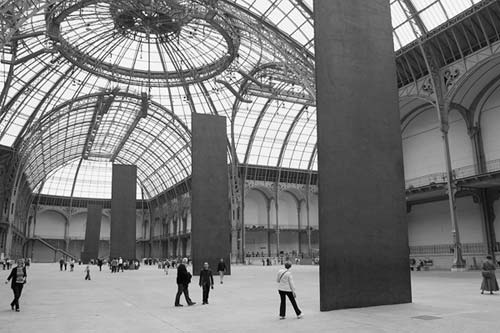
Cost and Hours: Admission prices and hours vary with each exhibition; major exhibitions usually €11-15, not covered by Museum Pass; generally open daily 10:00-20:00, Wed until 22:00, some parts of building closed Mon, other parts closed Tue, closed between exhibitions; Avenue Winston Churchill, Mo: Champs-Elysées Clemenceau or Franklin D. Roosevelt, tel. 01 44 13 17 17, www.grandpalais.fr.
For a remarkable Parisian panorama and a suitable location for your next affair, head to Hôtel Hyatt Regency and its Bar la Vue, on the 34th floor. Ride the free elevators (when entering, head to the rear of the lobby and take the elevators on the right), and walk up one flight to the bar. You’ll enter a sky-high world of colorful stools and swivel seats, glass walls, expensive drinks, and jaw-dropping views that are best before dark and not worthwhile in poor weather (bar open daily 17:00-1:00 in the morning, tel. 01 40 68 51 31, www.parisetoile.regency.hyatt.com).
Getting There: It’s at Porte Maillot (3 Place du Général Koenig). Take the Métro to the pedestrian-unfriendly Porte Maillot stop. Follow signs to Palais des Congrès, and enter the underground mall, turn right at the small sign for Hôtel Hyatt Regency, and walk straight until you arrive at the hotel (if you get lost there are maps everywhere in the mall). If you’re coming from the Rue Cler area, take RER-C from Invalides or Pont de l’Alma toward Pontoise to Porte Maillot. If you’re pooped or strapped for time, the skies are clear, and the sun’s about to set, spring for a taxi.
Though Paris keeps its historic center classic and skyscraper-free, this district, nicknamed “le petit Manhattan,” offers an impressive excursion into a side of Paris few tourists see: that of a modern-day economic superpower. La Défense was first conceived more than 60 years ago as a US-style forest of skyscrapers that would accommodate the business needs of the modern world. Today La Défense is a thriving commercial and shopping center, home to 150,000 employees and 55,000 residents.
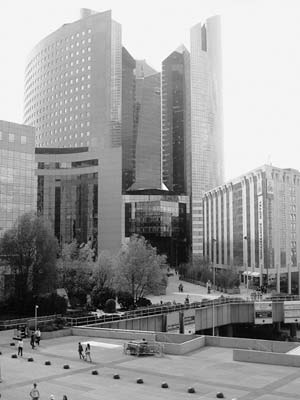
For an interesting visit, take the Métro to the La Défense Grande Arche stop, follow Sortie Grande Arche signs, and climb the steps of La Grande Arche for distant city views. Then stroll gradually downhill among the glass buildings to the Esplanade de la Défense Métro station, and return home from there.
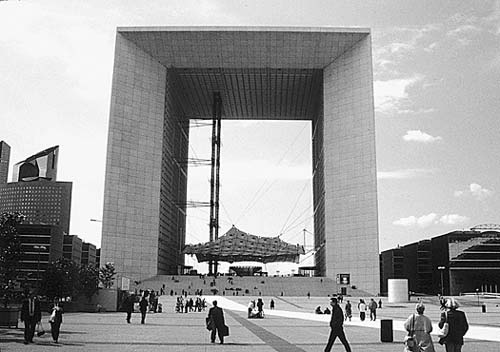
Visiting La Défense: The centerpiece of this ambitious complex is the mammoth La Grande Arche de la Fraternité. Inaugurated in 1989 on the 200th anniversary of the French Revolution, it was, like the Revolution, dedicated to human rights and brotherhood. The place is big—Notre-Dame Cathedral could fit under its arch. The four-sided structure sits on enormous underground pillars and is covered with a veneer of beautiful white Carrara marble. The arch is a 38-story office building for 30,000 people on more than 200 acres. The left side houses government ministries, the right side corporate offices, and the top is dedicated to human rights. The “cloud”—a huge canvas canopy under the arch—is an attempt to cut down on the wind-tunnel effect this gigantic building creates. Wander behind the arch to see an unusual mix of glassy skyscrapers and a cemetery (in the orchard), and peek at the Le Corbusier-style planning, separating motor traffic (the freeway and trains that tunnel underneath) from pedestrian traffic (the sky-bridges).
La Défense is much more than its eye-catching arch. Survey the skyscraping scene from the top of the arch steps. EDF is France’s national gas company; SFR is the Verizon of France; and Areva is a global energy company that is big into nuclear power. For lunch, join the locals and picnic on the steps; good to-go places are plentiful (and cafés are nearby).
From the arch, wander along the Esplanade (a.k.a. “le Parvis”), back toward the city center (and to the next Métro stop). Take in the monumental structures around you: Les Quatre Temps is a giant shopping mall of 250 stores, and like malls at home, it’s a teenage wasteland when school is out and eerily quiet at night.
Across the Esplanade to the left, the Center of New Industries and Technologies (better known as CNIT—see white letters on plaza), built in 1958 and now a congress center, is a feat of modern architecture: It’s the largest concrete vault anywhere that rests on only three points. Enter the vault to see a semicircle of dazzling offices and shops that recede as they rise, like the seating in an opera house.
In France, getting a building permit often comes with a requirement to dedicate two percent of the construction cost to art. Hence the Esplanade is a virtual open-air modern art gallery, sporting pieces by Joan Miró (blue, red, and yellow), Alexander Calder (red), and Yaacov Agam (the fountain with colorful stripes and rhythmically dancing spouts), among others. Find a copy of French artist César Baldaccini’s famous thumb in the center (40 feet high). La Défense de Paris, the statue that gave the area its name, recalls the 1871 Franco-Prussian war—it’s a rare bit of old Paris out here in the ’burbs.
As you descend the Esplanade, notice how the small gardens and boules courts (reddish dirt areas) are designed to integrate tradition into this celebration of modern commerce. Note also how the buildings decrease in height and increase in age—the Nexity Tower (closest to central Paris) looks old compared to the other skyscrapers. Dating from the 1960s, it was one of the first buildings at La Défense. Your walk ends at the amusing fountain of Bassin Takis, where you’ll find the Esplanade de la Défense Métro station that zips you out of all this modernity and directly back into town.
The old opera house anchors this neighborhood of broad boulevards and grand architecture. This area is also nirvana for high-end shoppers, with the opulent Galeries Lafayette, the delicate Fragonard Perfume Museum, and the sumptuous shops that line Place Vendôme and Place de la Madeleine. Key Métro stops for this area include Opéra, Madeleine, and Havre Caumartin (RER: Auber).
This gleaming grand theater of the belle époque was built for Napoleon III and finished in 1875. For the best exterior view, stand in front of the Opéra Métro stop. (To better understand what you’re seeing, read the “Baron Georges-Eugène Haussmann” sidebar on here.) From Avenue de l’Opéra, once lined with Paris’ most fashionable haunts, the facade suggests “all power to the wealthy.” And a shimmering Apollo, holding his lyre high above the building, seems to declare, “This is a temple of the highest arts.”
But the elitism of this place prompted former President François Mitterrand to have an opera house built for the people in the 1980s, situated symbolically on Place de la Bastille, where the French Revolution started in 1789. This left the Opéra Garnier home only to ballet and occasional concerts.
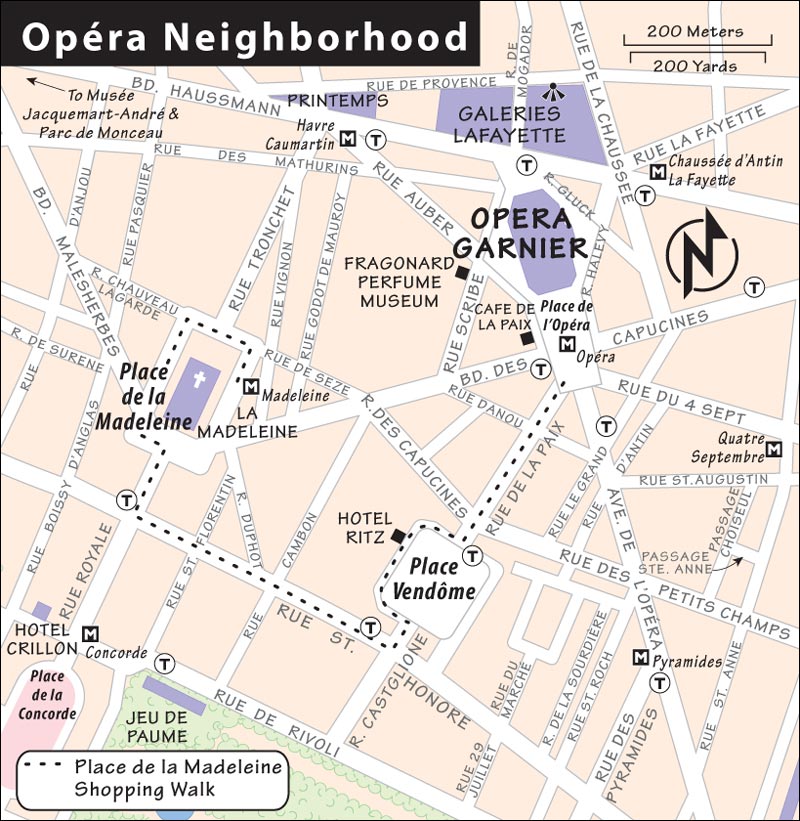
Cost and Hours: €10, not covered by Museum Pass, erratic hours due to performances and rehearsals, generally daily 10:00-16:30, mid-July-Aug until 18:00, last entry 30 minutes before closing, 8 Rue Scribe, Mo: Opéra, RER: Auber.
Tours: The €5 audioguide gives a good self-guided tour. Guided tours in English run during the summer and off-season on weekends and Wed, usually at 11:30 and 14:30—call to confirm schedule (€13.50, includes entry, 1.5 hours, tel. 01 40 01 17 89 or 08 25 05 44 05).
Ballet and Concert Tickets: To find out about upcoming performances, ask for a schedule at the information booth, consult Pariscope magazine (see here), or look on the website (www.operadeparis.fr). There are usually no performances mid-July-mid-Sept. It’s easiest to reserve online. To buy tickets by phone, call 08 92 89 90 90 (toll call) within France or 01 71 25 24 23 from outside France (office closed Sun). You can also go directly to the ticket office (open Mon-Sat 11:30–18:30 and an hour before the show, closed Sun).
Visiting the Theater: You’ll enter around the left side of the building (as you face the front), across from American Express on Rue Scribe. As you pass the bust of the architect, Monsieur Garnier, pay your respects and check out the bronze floor plan of the complex etched below. Notice how little space is given to seating.
The building is huge—though the auditorium itself seats only 2,000. The building’s massive foundations straddle an underground lake (inspiring the mysterious world of the Phantom of the Opera). The real show was before and after the performance, when the elite of Paris—out to see and be seen—strutted their elegant stuff in the extravagant lobbies. Think of the grand marble stairway as a theater. Is it just me, or does the upstairs foyer feel like it belongs at Versailles? As you wander the halls and gawk at the decor, imagine this place in its heyday, filled with beautiful people sharing gossip at the Salon du Glacier.
From the uppermost floor open to the public, visitors can peek from two boxes into the actual red-velvet performance hall. Admire Marc Chagall’s colorful ceiling (1964) playfully dancing around the eight-ton chandelier (guided tours take you into the performance hall; you can’t enter when they’re changing out the stage). Note the box seats next to the stage—the most expensive in the house, with an obstructed view of the stage...but just right if you’re here only to be seen. Snoop about to find the side library, information panels describing costume management, and a portrait gallery of famous ballerinas and guests.
For a novel souvenir, stop at the boutique as you leave and pick up a jar of honey cultivated from beehives on the Opéra’s roof (not always available). The hives are tended by staff and (they say) can be seen from the seventh floor of Galeries Lafayette (behind the Opéra).
Nearby: Across the street, the illustrious Café de la Paix has been a meeting spot for the local glitterati for generations. If you can afford the coffee, this spot offers a delightful break.
Near Opéra Garnier, this perfume shop masquerades as a museum. Housed in a beautiful 19th-century mansion, it’s the best-smelling museum in Paris—and you’ll learn a little about how perfume is made, too (ask for the English handout).
Cost and Hours: Free, daily 9:00-17:30, 9 Rue Scribe, Mo: Opéra, RER: Auber, tel. 01 47 42 04 56, www.fragonard.com.
This upscale neighborhood hosts some of Paris’ best shopping. Even window shoppers can appreciate this as a ▲ “sight.” Just behind the Opéra, the Galeries Lafayette department store is a magnificent cathedral to consumerism, under a stunning stained-glass dome (for more, see here of the Shopping in Paris chapter). The area between Place de la Madeleine, dominated by the Madeleine Church (looking like a Roman temple) and the octagonal Place Vendôme, is filled with pricey shops and boutiques, giving travelers a whiff of the exclusive side of Paris (for a boutique-to-boutique stroll through this area, see here).
This thoroughly enjoyable museum-mansion (with an elegant café) showcases the lavish home of a wealthy, art-loving, 19th-century Parisian couple. After visiting the Opéra Garnier and wandering Paris’ grand boulevards, get inside for an intimate look at the lifestyles of the Parisian rich and fabulous. Edouard André and his wife Nélie Jacquemart—who had no children—spent their lives and fortunes designing, building, and then decorating this sumptuous mansion. What makes the visit so rewarding is the excellent audioguide tour (in English, included with admission, plan on spending an hour with the audioguide). The place is strewn with paintings by Rembrandt, Botticelli, Uccello, Mantegna, Bellini, Boucher, and Fragonard—enough to make a painting gallery famous.
Cost and Hours: €12, not covered by Museum Pass; daily 10:00-18:00, Mon and Sat until 20:30 during special exhibits (which are common); can avoid lines (worst during the first week of special exhibits) by purchasing tickets online (€2 fee), includes audioguide, 158 Boulevard Haussmann, Mo: St. Philippe-du-Roule, bus #80 makes a convenient connection to Ecole Militaire; tel. 01 45 62 11 59, www.musee-jacquemart-andre.com.
After Your Visit: Consider a break in the sumptuous museum tearoom, with delicious cakes and tea (daily 11:45-17:30). From here walk north on Rue de Courcelles to see Paris’ most beautiful park, Parc Monceau.
The Marais neighborhood extends along the Right Bank of the Seine, from the Bastille to the Pompidou Center. The main east-west axis is formed by Rue St. Antoine, Rue des Rosiers (the heart of Paris’ Jewish community), and Rue Ste. Croix de la Bretonnerie. The centerpiece of the neighborhood is the stately Place des Vosges. Helpful Métro stops are Bastille, St-Paul, and Hôtel de Ville. To connect the following sights with a fun, fact-filled stroll from Bastille to the Pompidou,  see the Marais Walk chapter.
see the Marais Walk chapter.
Don’t waste time looking for the Bastille, the prison of Revolution fame. It’s Paris’ most famous nonsight. The building is long gone, and just the square remains, good only for its nightlife and as a jumping-off point for the Marais Walk or a stroll through Promenade Plantée Park (see here).
The tumultuous history of Paris—starring the Revolutionary years—is well portrayed in this converted Marais mansion. Explanations are in French only, but many displays are self-explanatory. You’ll see models of medieval Paris, maps of the city over the centuries, paintings of Parisian scenes, French Revolution paraphernalia—including a small guillotine—and fully furnished rooms re-creating life in Paris in different eras.
Cost and Hours: Free, fee for some temporary (but optional) exhibits, Tue-Sun 10:00-18:00, closed Mon; avoid lunchtime (11:45-14:30), when many rooms may be closed; audioguide-€5, 23 Rue de Sévigné (entrance is off Rue des Francs-Bourgeois), Mo: St-Paul, tel. 01 44 59 58 58, www.carnavalet.paris.fr.
 See the Carnavalet Museum Tour chapter.
See the Carnavalet Museum Tour chapter.
Whatever you think about Picasso the man, as an artist he was unmatched in the 20th century for his daring and productivity. The Picasso Museum has the world’s largest collection of Picasso’s work. Following a complete, multi-year, multi-million-dollar renovation, the Picasso Museum should be reopened by the time you visit. Some 400 paintings, sculptures, sketches, and ceramics are here, spread across four levels of this mansion in the Marais. A visit here walks you through the full range of this complex man’s life and art.
Cost and Hours: When it reopens, likely about €10, covered by Museum Pass, additional fee for temporary exhibits, may be free on first Sun of month and for those under age 18 with ID; likely open daily 9:00-19:30, some Sat until 22:00, last entry 45 minutes before closing; 5 Rue de Thorigny, Mo: St-Paul or Chemin Vert, tel. 01 42 71 25 21, www.musee-picasso.fr.
 For a short Picasso biography and an overview of some of the collection’s highlights, see the Picasso Museum Tour chapter.
For a short Picasso biography and an overview of some of the collection’s highlights, see the Picasso Museum Tour chapter.
This fine museum, located in a beautifully restored Marais mansion, reconstructs the culture of community through its artistic heritage. It tells the story of Judaism in France and throughout Europe, from the Roman destruction of Jerusalem to the theft of famous artworks during World War II. Displays illustrate the cultural unity maintained by this continually dispersed population. You’ll learn about the history of Jewish traditions, from bar mitzvahs to menorahs, and see the exquisite costumes and objects central to daily life. The museum also displays paintings by famous Jewish artists, including Marc Chagall, Amedeo Modigliani, and Chaim Soutine. English explanations posted in many rooms provide sufficient explanation for most; the included audioguide provides greater detail.
Cost and Hours: €8, covered by Museum Pass; Sun 10:00-18:00, Mon-Fri 11:00-18:00, Wed until 21:00 during special exhibits, closed Sat, last entry 45 minutes before closing; includes audioguide, 71 Rue du Temple; Mo: Rambuteau or Hôtel de Ville a few blocks farther away, RER: Châtelet-Les Halles; tel. 01 53 01 86 60, www.mahj.org.
This sight, commemorating the lives of the more than 76,000 Jews deported from France in World War II, has several facets: a WWII deportation memorial, a museum on the Holocaust, and a Jewish resource center. Displaying original deportation records, the museum takes you through the history of Jews in Europe and France, from medieval pogroms to the Nazi era. But its focal point is underground, where victims’ ashes are buried.
Cost and Hours: Free, Sun-Fri 10:00-18:00, Thu until 22:00, closed Sat and certain Jewish holidays, 17 Rue Geoffroy l’Asnier, tel. 01 42 77 44 72, www.memorialdelashoah.org.
Visiting the Memorial: Before entering, notice the large bronze wall plaque honoring those who risked their lives for Jewish people. Visitors must pass through airport-like security. The entry courtyard contains a cylinder evoking concentration camp smokestacks. Down three steps, large stone walls are engraved with the names of all of the French Jews deported during the war.
Enter the building (with an information desk, bookstore, café, and exhibits), and pick up the Mémorial de la Shoah brochure. Go downstairs one floor to the crypt, which has a large Star of David in black marble. Ashes from some of the six million victims of Nazi brutality are buried underneath the star, in soil brought from Israel. Behind you is a small corridor containing the original French police files from the arrest, internment, and deportation of Paris’ Jews. (Since 1995, the French—thanks to former President Jacques Chirac’s leadership—have acknowledged the Vichy government’s complicity in the Nazis’ local ethnic cleansing.)

Go downstairs another floor to the permanent exhibition. Photos and videos (most with English explanations) present an introduction to Judaism and the history of Jews in Europe (including pogroms) and in France (including the notorious Dreyfus affair, concerning a Jewish officer unjustly imprisoned for treason). The displays trace the rise of Nazism, the deportations (12,884 Parisians were once rounded up in a single day), the death camps, and the liberation at the end of the war. The moving finale is a brightly lit collage of children lost to the Holocaust.
One of Europe’s greatest collections of far-out modern art is housed in the Musée National d’Art Moderne, on the fourth and fifth floors of this colorful exoskeletal building. Created ahead of its time, the 20th-century art in this collection is still waiting for the world to catch up. After so many Madonnas-and-children, a piano smashed to bits and glued to the wall is refreshing.
The Pompidou Center and the square that fronts it are lively, with lots of people, street theater, and activity inside and out—a perpetual street fair. Kids of any age enjoy the fun, colorful fountain (called Homage to Stravinsky) next to the Pompidou Center. Ride the escalator for a great city view from the top (ticket or Museum Pass required), and consider eating at the good café.
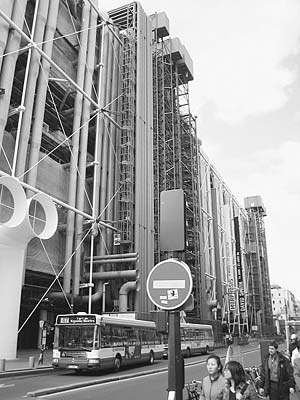
Cost and Hours: €13, free on first Sun of month, Museum Pass covers permanent collection and view escalators (but not temporary exhibits), €3 Panorama Ticket lets you ride to the sixth floor for the view (doesn’t include museum entry); Wed-Mon 11:00-21:00, closed Tue, ticket counters close at 20:00, arrive after 17:00 to avoid crowds (mainly for special exhibits); audioguide-€5 (rent on ground floor), café on mezzanine, pricey view restaurant on level 6, Mo: Rambuteau or Hôtel de Ville, tel. 01 44 78 12 33, www.centrepompidou.fr.
 See the Pompidou Center Tour chapter.
See the Pompidou Center Tour chapter.
This two-mile-long, narrow garden walk on an elevated viaduct was once used for train tracks and is now a pleasing place for a refreshing stroll or run (especially for those sleeping in the Marais). Botanists appreciate the well-maintained and varying vegetation. From west (near Opéra Bastille) to east, the first half of the path is elevated until the midway point, the pleasant Jardin de Reuilly (a good stopping point for most, near Mo: Dugommier), then it continues on street level—with separate paths for pedestrians and cyclists—out to Paris’ ring road, the périphérique.
Cost and Hours: Free, opens Mon-Fri at 8:00, Sat-Sun at 9:00, closes at sunset (17:30 in winter, 20:30 in summer). It runs from Place de la Bastille (Mo: Bastille) along Avenue Daumesnil to St. Mandé (Mo: Michel Bizot) or Porte Dorée, passing within a block of Gare de Lyon.
Getting There: To get to the park from Place de la Bastille (exit the Métro following Sortie Rue de Lyon signs), walk a looooong block down Rue de Lyon, hugging the Opéra on your left. Find the low-key entry and steps up the red-brick wall a block after the Opéra.
Littered with the tombstones of many of the city’s most illustrious dead, this is your best one-stop look at Paris’ fascinating, romantic past residents. More like a small city, the cemetery is big and confusing, but my self-guided tour directs you to the graves of Frédéric Chopin, Molière, Edith Piaf, Oscar Wilde, Gertrude Stein, Jim Morrison, Héloïse and Abélard, and many more.
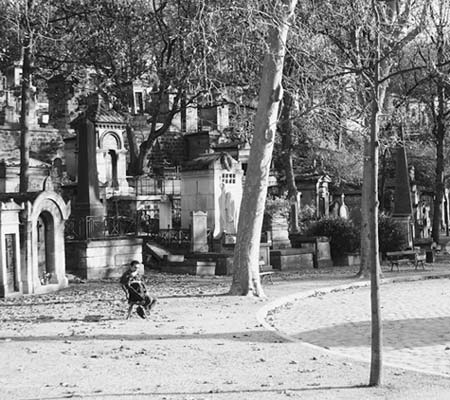
Cost and Hours: Free, Mon-Fri 8:00-18:00, Sat 8:30-18:00, Sun 9:00-18:00, closes at 17:30 in winter, last entry 15 minutes before closing; two blocks from Mo: Gambetta (do not go to Mo: Père Lachaise) and two blocks from bus #69’s last stop (see the Bus #69 Sightseeing Tour chapter); tel. 01 55 25 82 10, searchable map available at non-official website: www.pere-lachaise.com.
 See the Père Lachaise Cemetery Tour chapter.
See the Père Lachaise Cemetery Tour chapter.
France’s literary giant lived in this house on Place des Vosges from 1832 to 1848. (Hugo stayed in many places during his life, but he was here the longest.) He moved to this apartment after the phenomenal success of The Hunchback of Notre-Dame, and it was while living here that he wrote much of Les Misérables (when he wasn’t entertaining Paris’ elite). You’ll see well-decorated rooms re-creating different phases of his life, from his celebrity years, to his 19-year exile during the repressive reign of Napoleon III (Hugo said “When freedom returns, I will return”), to his final years as a national treasure. Rooms are littered with paintings of Hugo and his family and of some of his most famous character creations. The display cases show personal objects. Posted explanations in English provide sufficient context to grasp the importance of Hugo to France. The €5 audioguide adds greater depth.
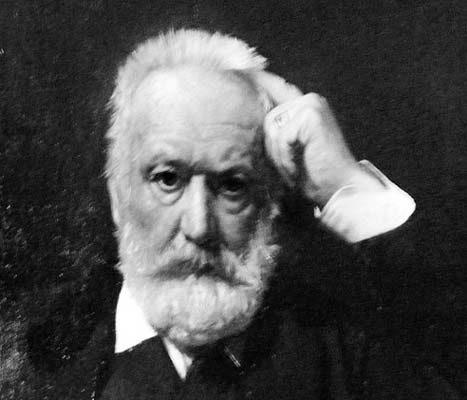
Cost and Hours: Free, fee for optional exhibits (usually about €7, and usually not worth paying for), Tue-Sun 10:00-18:00, closed Mon, last entry at 17:40, audioguide-€5, 6 Place des Vosges; Mo: Bastille, St-Paul, or Chemin Vert; tel. 01 42 72 10 16, www.musee-hugo.paris.fr.
Paris’ highest hill, topped by Sacré-Cœur Basilica, is best known as the home of cabaret nightlife and bohemian artists. Struggling painters, poets, dreamers, and drunkards came here for cheap rent, untaxed booze, rustic landscapes, and views of the underwear of high-kicking cancan girls at the Moulin Rouge. These days, the hill is equal parts charm and kitsch—still vaguely village-like but mobbed with tourists and pickpockets on sunny weekends. Come for a bit of history, a get-away from Paris’ noisy boulevards, and the view.
Connect the following sights with the  Montmartre Walk chapter.
Montmartre Walk chapter.
You’ll spot Sacré-Cœur, the Byzantine-looking white basilica atop Montmartre, from most viewpoints in Paris. Though only 130 years old, it’s impressive and iconic, with a climbable dome.
Cost and Hours: Church—free, daily 6:00-22:30, last entry at 22:15; dome—€6, not covered by Museum Pass, daily May-Sept 9:00-19:00, Oct-April 9:00-17:00; tel. 01 53 41 89 00, www.sacre-coeur-montmartre.com.
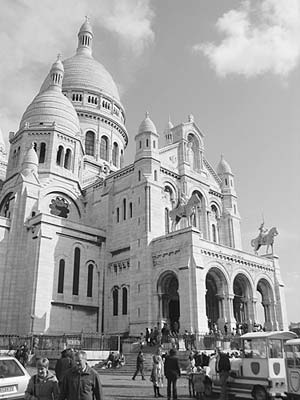
Getting There: You have several options. You can take the Métro to the Anvers stop (to avoid the stairs up to Sacré-Cœur, buy one more Métro ticket and ride up on the funicular). Alternatively, from Place Pigalle, you can take the “Montmartrobus,” a city bus that drops you right by Sacré-Cœur (Funiculaire stop, costs one Métro ticket, 4/hour). A taxi from the Seine or the Bastille saves time and avoids sweat (about €15, €20 at night).
Nearby: Montmartre’s main square (Place du Tertre), one block from the church, was once the haunt of Henri de Toulouse-Lautrec and the original bohemians. Today, it’s mobbed with tourists and unoriginal bohemians, but it’s still fun (to beat the crowds, go on a weekday or early on weekend mornings).
This museum offers an entertaining look at some of Dalí’s creations.
Cost and Hours: €11.50, not covered by Museum Pass, daily 10:00-18:00, July-Aug until 20:00, audioguide-€3, 11 Rue Poulbot, tel. 01 42 64 40 10, www.daliparis.com.
This 17th-century home re-creates the traditional cancan-and-cabaret Montmartre scene, with paintings, posters, photos, music, and memorabilia.
Cost and Hours: €9, not covered by Museum Pass, daily 10:00-18:00, last entry 30 minutes before closing, includes good audioguide, 12 Rue Cortot, tel. 01 49 25 89 39, www.museedemontmartre.fr.
Paris’ red light district, the infamous “Pig Alley,” is at the foot of Butte Montmartre. Ooh la la. It’s more racy than dangerous. Walk from Place Pigalle to Place Blanche, teasing desperate barkers and fast-talking temptresses. In bars, a €150 bottle of (what would otherwise be) cheap champagne comes with a friend. Stick to the bigger streets, hang on to your wallet, and exercise good judgment. Cancan can cost a fortune, as can con artists in topless bars. After dark, countless tour buses line the streets, reminding us that tour guides make big bucks by bringing their groups to touristy nightclubs like the famous Moulin Rouge (Mo: Pigalle or Abbesses).